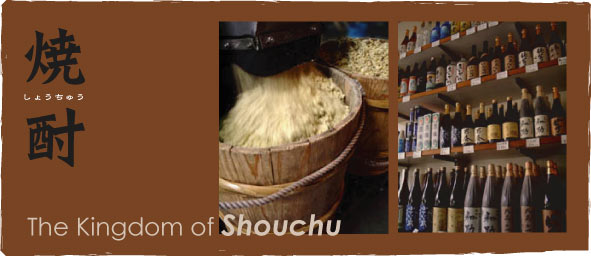Every country in the world
has its own alcoholic drink. Wine in France and Italy, tequila
in Mexico, Scotch in Ireland, sake in Japan... and shouchu in Kyushu
and Okinawa.
Kagoshima is the kingdom of shouchu. Kagoshima is the Japan's largest
shouchu maker and the main maker of imo-jouchu (sweet
potato shouchu). You can't talk about Kagoshima without talking about
Shouchu. "Sake" means "Shouchu" in Kagoshima.
112 shouchu factories produce over 1150 kinds of shouchu with both
traditional and high technology methods in Kagoshima prefecture (as
of May, 2002).
Some people say "I don't like the smell of imo-jochu!" But,
imo-jochu without smell is not a real imo-jouchu. The fascination
of imo-jochu resides on its aroma and deep sweet potato flavor.
Winter is the best season to enjoy a cup of warmed Shouchu.
Warm up drinking shouchu with friends during dinner !! |
|
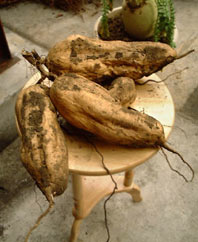
Sweet potatoes "Kogane sengan"
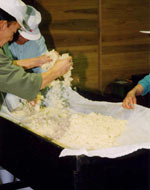
Mixing yeast to the rice...
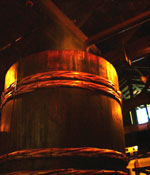
distillation by traditional method
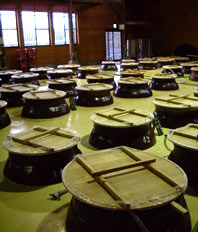
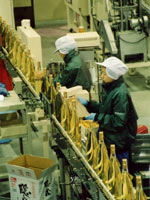
High technology method
|
 |
| |
In general, shouchu is a distilled
alcoholic drink made from grains. It is classified in 2 types:
Ko and Otsu. Ko-type shouchu is a drink with less than 36 %
alcohol, and it has no flavor and nor aroma due to several distillations.
Otsu-type shouchu is a drink with less than 45 % alcohol, and
its preparation use a variety of raw materials like rice (kome),
sweet potatoes (satsuma-imo), wheat (mugi), black-sugar (Kokutou),
buckwheat (soba), and potatoes (jyagaimo); this type has full
flavor and characteristic aroma because it is distilled only
once. Otsu type shouchu is called "Honkaku Shochu (Genuine
Shochu)." Kagoshima's shouchu is mainly made from sweet
potatoes, since Kagoshima prefecture is the top producer of
sweet potato. "Imo-jouchu" is produced during the
harvest season from August to December, since sweet potatoes
cannot be preserved for a long time like rice or wheat.
Northern Japan produces many kinds of sake, but Kiushu produce
many kinds of shouchu, with its original taste and fresh aroma,
given by the particular land and weather of the region.
Fukuoka: Sake lees & sesami
Nagasaki: Weat
Oita: Wheat
Kumamoto: Rice
Miyazaki: sweet potato & buckwheat
Kagoshima: Sweet potato
brown sugar (Amami islands)
Okinawa: Rice |
 |
| |
It is believed that the distilled
spirit were brought to Kagoshima from China via Okinawa. Shouchu
doesn't have a long history such as sake. Okinawa's brown sugar
shouchu (called "Awamori") is the oldest one, and
it has over 500 years history, while other kinds of shouchu
made from rice, sweet potato or wheat have no more than 300
~400 years history.
The oldest record of Shochu is a letter compiled in the "Japan
Experience" book. In 1546, a Portuguese who lived in Yamagawa
Town (Kagoshima pref.) wrote a letter to Fransico Xavier reporting
that: "Orragua (rice Shchu) is drunk here". In Hachiman
shrine of Okuchi City (Kagoshima pref.), another record about
shochu was found. It is wood piece, which was written by a carpenter
in 1559. The following scribble was found on the wood piece:
"The head carpenter is very mean; he didn't let us drink
shochu at all."
At the beginning, rice shochu and millet shochu was mainly produced
in Kagoshima. Sweet potatoes, which are originally from Central-South
America, were brought to Kagoshima from China via Okinawa in
the late 16th century. Kagoshima had pumiceous tablelands, which
are not suitable for rice Production, but sweet potatoes were
very suitable, and quickly became the largest producer of sweet
potato. And naturally, sweet potato shochu (imo-jouchu) became
the main shochu since the beginning of 17th century.
At present, Shochu is only used as an alcoholic drink, but it
had important medical use as a disinfectant until the end of
the Edo period (1600-1868). |
 |
| |
* Shouchu is good for blood circulation.
* Shouchu is the lowest calorie alcohol
* Shouchu is good with natto: If you eat natto and drink shouchu,
blood circulations will be better.
* Shouchu usually doesn't give you hangover and easy for sobering
up compare to sake and wine.
* Shouchu makes you HAPPY!! |
 |
| |
Sake is a fermented rice wine made
from rice, koji (malted rice which acts as a yeast) and water.

|
|
| |
|
 |
|
|
 |
| |
You can enjoy
shouchu in many variations. The most popular way to drink shouchu
is with warm water ("oyu-wari"); it is the best way
to bring out the shouchu's flavor and aroma. And, if you want to taste
the flavor and aroma of sweet potato, it better not to mix with other
drink. Kagoshima people say "Dareyame" (it
means: drink at supper to take away fatigue.) in Kagoshima dialect.
Enjoy your "Dareyame" with Shouchu!
1) "Oyu-wari": Shouchu with warm water
Shouchu 60 % : Hot water 40 % (but as you like...)
Put the hot water first, and add shochu.
2) "Mizu-wari": Shouchu with cold water
Shouchu 60 % and cold water (mineral water) 40 %.
Put shouchu first, and add cold water.
3) "On the rocks": Shouchu on the rocks!!
Put some ice cubes in a glass, and pour Shouchu!
You can taste the real flavor of Shochu in this way...
"Shouchu in Kuro-jyoka"
Drinking shouchu with kuro-jyoka is the most
delicious and traditional way of drinking Shouchu
(especially Imo-jouchu) in Kagoshima.
1. Mix shouchu (60%) and hot water (40%) on the day
before, so that the flavor becomes mild.
2. When you drink, put 1 in Kuro-jyoka (Black satsuma
sake pot) and warm it to body temperature.
3. And drink it!!
* Don't wash the kuro-joka after; just keep using the same pot!! |
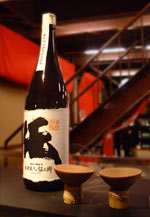
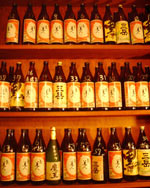
Shouchu "Keep bottle" at Japanese restaurant in Kagoshima.
You buy a bottle of shouchu, and you can just drink your keep bottle
free after. |
 |
| |
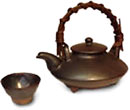 |
黒ぢょか kuro-jyoka
It is Kagoshima's typical sake pot which is made from
black satsuma clay. There are also Shiro-jyoka (White
satsuma sake pot). Shochu in kuro-jyoka won't get cold
quickly. |
|
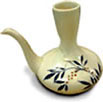 |
カラカラ Kara-kara
It is an unique shape sake pot. The pot is mainly used
in Southern Kyushu. It's said that it was named Karakara,
because it originally came from China ("Kara"
in that time). |
|
 |
Cup for "Oyu-wari"
(shouchu with warm water). Graduation line are signed
on the cup. The cup is very common!! |
 |
ソラキュー Sorakyu
Bottom is not flat, so that you have to drink all up.
|
 |
チョク Choku
|
|
|
|
